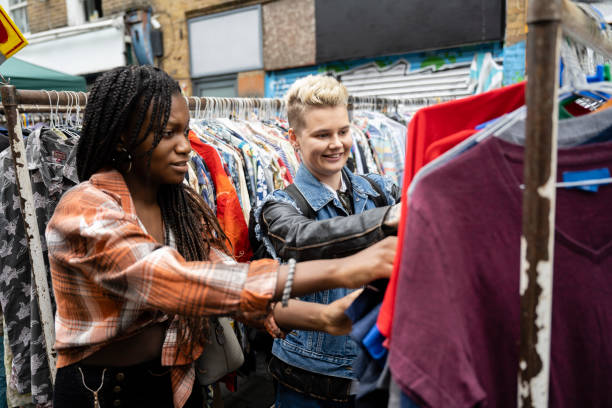In the dynamic world of UK fashion retailing, the strategies that fashion brands employ for getting their products into customers’ hands are as vital as the fashions themselves. Among these strategies, retail distribution plays a critical role in the success of these businesses. From traditional retail stores to innovative online platforms, UK clothing retailers utilize a variety of distribution channels to maximize their reach. This article reveals the multi-faceted approaches to distribution that fashion retailers have adopted and explores how a carefully crafted distribution strategy could help penetrate new markets and improve overall sales performance.

The Backbone of Retail: An Overview of Distribution Channels
Distribution channels are the pathways through which products travel from manufacturers selling direct to consumers or through intermediaries. In the UK, fashion retailers adopt diverse channels, understanding that the right mixture will help meet customer demands effectively. An effective distribution strategy involves not just having products available but also ensuring that they align with brand positioning and customer expectations. Channels vary greatly, from direct sales in owned retail stores to leveraging partnerships with third-party retailers.
Brick-and-Mortar Stores: The Traditional Route
Despite the rise of online retail, brick-and-mortar stores remain a cornerstone for fashion brands. They serve as a physical representation of the brand and provide the tactile shopping experience that many customers still value. Location choice and store design play crucial roles in attracting foot traffic, while efficient inventory management systems can ensure that the most popular items are always in stock. Hands-on customer service and the ability to try on clothing before purchase are unique advantages that these stores hold over their digital counterparts.
The Digital Shift: Online Distribution
The surge of online sales has been transformative for UK fashion retailers. Individual brands’ websites and multi-brand platforms both serve as key direct channels for reaching customers. The integration of advanced e-commerce systems with user-friendly interfaces, coupled with targeted digital marketing efforts, can exponentially increase online visibility and sales. However, challenges remain, especially in efficiently managing warehousing and fulfilment operations to meet the immediate gratification customers expect from online shopping.
Omni-Channel Strategy: Blending Physical and Digital
Today’s retail distribution is not limited to a single channel; instead, an omni-channel strategy is becoming the norm. This strategy involves the integration of various channels—online, in-store, and mobile—to provide a seamless and cohesive shopping experience for customers. Fashion retailers that excel in omni-channel retailing use technology to sync inventory and customer data across platforms, ensuring availability and personalization. Numbered lists of key components in a successful omni-channel strategy may include:
- Consistency in branding and customer experience across all channels
- Real-time inventory visibility to avoid stockouts and overstocking
- A unified customer service approach addressing inquiries from all channels
- Integrated return and exchange policies for items bought online or in-store
Alternative Distribution Avenues
UK fashion retailers are not shy about experimenting with alternative distribution methods. Pop-up shops help in market testing and creating buzz, while subscription box services offer personalization and convenience. Moreover, collaboration with established third-party platforms could also extend reach and credibility. Numbered lists may also highlight the different alternative methods currently being explored:
- Limited edition collaborations released through occasional pop-up events
- Partnerships with niche online marketplaces catering to specific fashion segments

Logistical management remains a daunting task for fashion retailers, where having efficient systems in place can break or make the entire distribution process. The methods to ensure smooth logistics could involve everything from optimizing route planning for deliveries to implementing software that predicts demand. Automating processes where possible will help minimize errors and speed up the flow of goods from warehouse to customer.
Sustainability and Ethics in Distribution
As public awareness of environmental issues grows, UK fashion brands are under pressure to adopt more sustainable and ethical distribution practices. These may include using recycled materials for packaging, optimizing delivery routes to reduce carbon emissions, and ensuring fair labor practices across the supply chain. Following this eco-conscious approach not only appeals to the ethical consumer but could also improve long-term brand loyalty.
The Future of Retail Distribution
The retail distribution landscape is ever-evolving, with innovations on the horizon poised to further transform how fashion products are sold and delivered. Anticipating these changes requires an understanding that today’s novel technologies might soon become tomorrow’s industry standards. Below is a table outlining potential future trends and their implications for retail distribution:
| Trend | Implications for Retailers |
|---|---|
| Artificial Intelligence | Improved demand forecasting and personalized shopping experiences |
| Blockchain Technology | Enhanced transparency and security across the supply chain |
| Drone Delivery | Faster, more efficient order fulfilment |

Conclusion
In conclusion, UK clothing retailers have embraced a variety of distribution methods to stay competitive and cater to diverse consumer preferences. From the traditional brick-and-mortar stores to cutting-edge online platforms, each distribution channel offers unique benefits. The future promises even greater integration of technologies, which will demand continuous adaptation and innovation in distribution strategies. Ultimately, those fashion retailers that can integrate these methods effectively, leveraging their strengths and addressing their limitations, will thrive in the dynamic UK retail market.
FAQs
Q1: What are some of the biggest challenges UK clothing retailers face with distribution?
A1: The main challenges include managing logistics and supply chain efficiency, adapting to the rise of e-commerce, maintaining sustainability in operations, and providing a seamless customer experience across various distribution channels.
Q2: How has the COVID-19 pandemic affected the distribution methods of UK clothing retailers?
A2: The pandemic has accelerated the shift towards e-commerce and prompted retailers to improve their online platforms. It also created a need for more flexible and resilient supply chains, as well as contactless delivery options for customers.
Q3: Why is an omni-channel approach beneficial for UK clothing retailers?
A3: An omni-channel approach allows retailers to provide a cohesive shopping experience across multiple touchpoints, including in-store and online platforms, which can enhance customer satisfaction, loyalty, and ultimately, sales.
Q4: Can online distribution channels completely replace brick-and-mortar stores for UK clothing retail?
A4: While online distribution has grown significantly, brick-and-mortar stores still offer unique value through customer experiences that cannot be fully replicated online. Retailers often use a combination of both to cater to diverse shopping preferences.
Q5: How are UK clothing retailers incorporating sustainability into their distribution methods?
A5: Retailers are adopting eco-friendly packaging, optimizing transportation routes to reduce emissions, sourcing materials sustainably, and implementing recycling programs, among other initiatives, in an effort to minimize their environmental impact.
